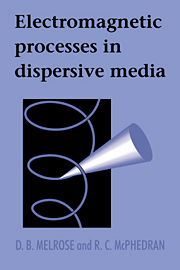Book contents
- Frontmatter
- Contents
- Preface
- List of Symbols
- Part One Electromagnetic Fields in Vacuo
- Chapter 1 Electromagnetic Fields
- Chapter 2 Cartesian Tensors
- Chapter 3 The Stress Tensor and Multipole Moments
- Chapter 4 Fourier Transforms
- Chapter 5 Greens Functions
- Part Two Electromagnetic Responses of Media
- Part Three Wave Properties
- Part Four Theory of Emission Processes
- Part Five Specific Emission Processes
- Bibliographic Notes
- Index
Chapter 1 - Electromagnetic Fields
Published online by Cambridge University Press: 27 October 2009
- Frontmatter
- Contents
- Preface
- List of Symbols
- Part One Electromagnetic Fields in Vacuo
- Chapter 1 Electromagnetic Fields
- Chapter 2 Cartesian Tensors
- Chapter 3 The Stress Tensor and Multipole Moments
- Chapter 4 Fourier Transforms
- Chapter 5 Greens Functions
- Part Two Electromagnetic Responses of Media
- Part Three Wave Properties
- Part Four Theory of Emission Processes
- Part Five Specific Emission Processes
- Bibliographic Notes
- Index
Summary
Preamble
The electromagnetic field may always be described in terms of two basic fields: the electric field strength E and the magnetic induction B. The sources for these fields are the charge density ρ and the current density J. The sources and the fields are related by Maxwell's equations. Maxwell's equations are four simultaneous first order differential equations and one cannot solve them directly to find the fields given the source terms. One way of solving Maxwell's equations is to introduce an alternative description of an electromagnetic field in terms of the scalar potential φ and vector potential A. These potentials are not uniquely defined and a specific choice for them satisfies a gauge condition.
Maxwell's Equations
The electric fieldE is defined as the force per unit charge acting on a test charge. Thus, if q is an arbitrarily small test charge (so that the electric field that it generates is negligible) located at a point a distance x from the origin at time t, then the electric force on it is qE(t,x). (For simplicity in notation, and where no confusion is likely to arise, the dependences on t and x are not shown explicitly.) The units of electric field strength are thus those of a force (kg m s−2) per unit charge; the unit of charge is the Coulomb (C) so that the magnitude of E has units kg m s−2C−1.
- Type
- Chapter
- Information
- Electromagnetic Processes in Dispersive Media , pp. 2 - 12Publisher: Cambridge University PressPrint publication year: 1991



